Contents
Edible honeysuckle has a number of advantages over other berry bushes. It ripens first, bears fruit annually, is rich in useful substances. What is significant, the plant does not require special care and endures severe frosts, therefore it can be grown almost throughout Our Country.

Variety description
Honeysuckle Nymph was created by free pollination of the Leningradsky Velikan variety by the All- Research Institute of Plant Industry named after. Vavilov in 1992. The cultivar was adopted by the State Register in 1998 after testing and recommended for cultivation in all regions.
TECH SPECS
Variety Nymph forms a tall, slightly sprawling bush with thick straight branches. The leaves are large, dark green in color, covered with a light hard fluff. Young shoots are light green, slightly fleecy.
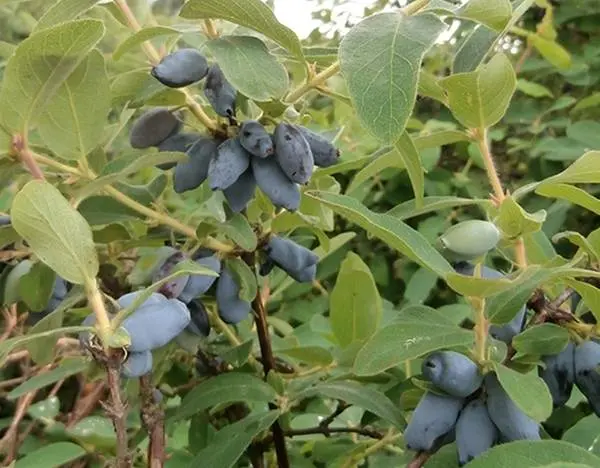
The berries of Nymph honeysuckle are medium in size – from 0,8 g to 1,1 g. They are colored blue, but due to the wax coating they look blue. The skin of long spindle-shaped fruits of medium density, bumpy. The maximum yield of an adult bush is 2 kg, the average is 1,3 kg. With industrial cultivation, 37 kg / ha can be collected.
Tasting evaluation of honeysuckle Nymph – 4,7 points. The taste is sweet, with a spicy bitterness. The berries are fragrant, universal purpose, mid-early ripening, crumble weakly.
Pollinators
Variety Nymph is self-infertile. Any cultivars can be used as pollinators; Morena, Amphora, Viola, Blue Spindle are well suited. Bees and bumblebees do not need to be specially attracted to the site – honeysuckle is a good honey plant.
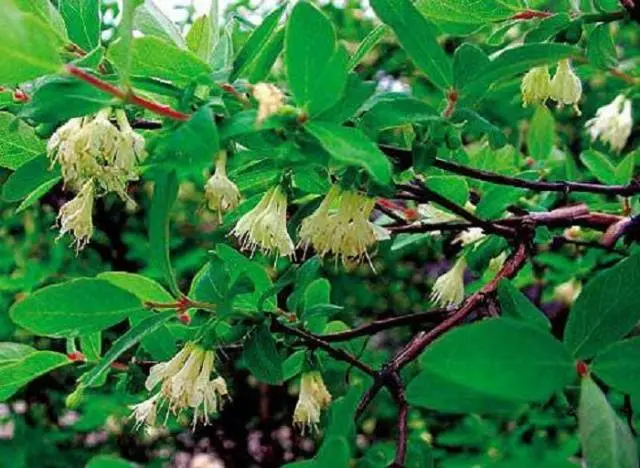
Advantages and disadvantages
The variety does not belong to the newest, it is already 20 years old. Although the Nymph is not as large-fruited as the Daughter of the Giant, and its yield is much lower than that of the Bakcharsky Giant, all the qualities of this honeysuckle have been tested by time. Its advantages include:
- High nutritional and medicinal value of berries.
- The ability to grow a variety throughout Our Country.
- fruiting stability.
- Low susceptibility of Nymph aphids.
- High winter hardiness.
- Ripening, the berries almost do not crumble.
- Taste – 4,7 points.
- Ease of care.
- The high decorativeness of the bush allows you to use the Nymph to decorate the site.
- The productive period is up to 30 years.

Among the shortcomings of the honeysuckle of the Nymph variety, in addition to self-infertility, can be called:
- Insufficient yield.
- Small weight of berries.
- Instability to repeated flowering, especially in the southern regions.
But let’s not forget that the variety was created at the end of the last century. The fact that he is inferior to the latest cultivars rather speaks not of his shortcomings, but of a high level of selection.
Accommodation on the site
Honeysuckle Nymph grows well throughout the Federation. It can be called a variety for those who do not like surprises.
Selection of planting material
In order for honeysuckle to take root better, you need to choose seedlings at the age of 2-3 years. She should have several well-developed strong branches with the same internodes. Buy container plants whenever possible. If the seedling has an open root system, pay attention to it – there should be no severe damage, black spots and signs of rot.
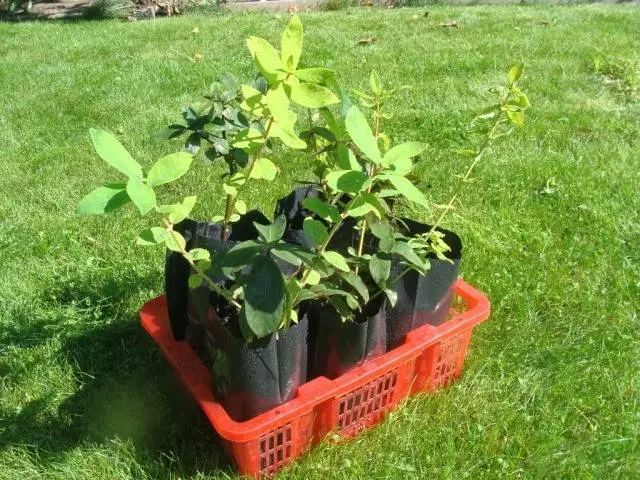
Selecting a suitable site and preparing the ground
It is important to choose a sunny area protected from strong cold winds for planting edible honeysuckle. All kinds of depressions, lowlands or depressions are not suitable due to the possible stagnation of water and the accumulation of cold air.
Variety Nymph will grow on any soil, but will give the best yields on loose, fertile, slightly acidic soils. Sandstones do not contribute to the setting of a large number of large berries. Acidic soils need liming – adding 200-400 g of fluff to the planting pit.
Honeysuckle Nymph can be planted according to the standard scheme – 1,5 m between plants, rows – at a distance of 2 m from each other. The variety looks very beautiful, bushes can be placed around the perimeter of the site to cover less attractive undersized crops.
Planting honeysuckle
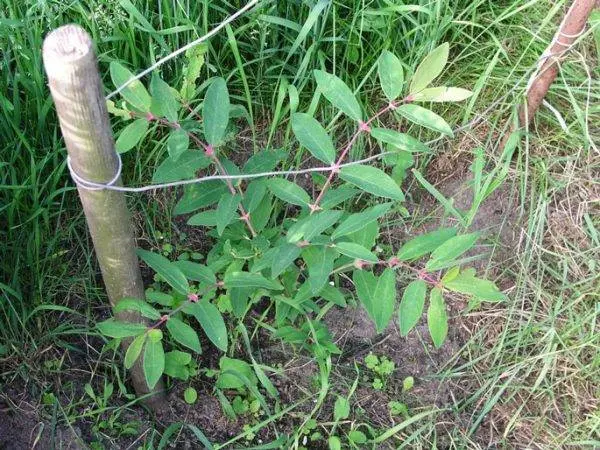
Planting pits for honeysuckle are dug 40x40x40 cm in size. Then a bucket of humus or compost is mixed with the top fertile soil layer, phosphate and potash fertilizers (50 g each). Then:
- Fill the planting hole with water.
- When it is absorbed, a nutrient mixture is poured in the middle.
- A seedling is placed on top.
- Roots are straightened around the mound.
- Fill the hole with soil so as to deepen the neck by 5 cm.
- Carefully ram the ground.
- Honeysuckle is watered, spending at least 10 liters of water for each bush.
- Mulch the trunk circle with peat, humus or dry earth.
Cultivation of honeysuckle
Honeysuckle is easy to care for, it is not capricious and rarely gets sick. The main thing is to choose the right place and plant the plant.
young plant care
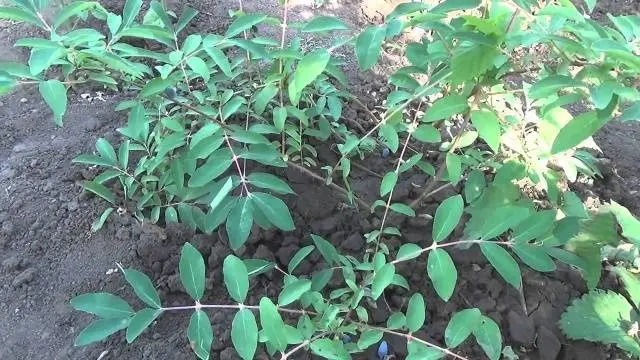
Only young honeysuckle in the year of planting requires close attention. It needs to be watered regularly so that the root does not dry out. When the top layer of soil dries out a little, the soil is loosened to a depth of 5-8 cm. Weeds are removed from the trunk circle.
If fertilizers were added to the planting hole, the first 2 years are limited to spring nitrogen fertilization. It is better to do it on snow that has not yet melted – add ammonium nitrate or urea to a bucket of water according to the instructions and water the honeysuckle.
Care for an adult plant
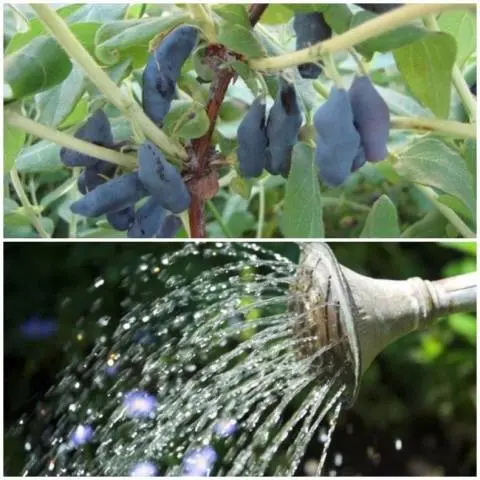
Adult bushes are watered as needed, loosen the soil and weed out. The trunk circle is mulched with organic matter. The stern of the annual spring top dressing after the fruiting of honeysuckle is given a complete mineral complex, and in early autumn – phosphorus-potassium fertilizers.
Pruning and wintering
There is no need for regular pruning of young honeysuckle. How and when to remove branches is indicated in the table.
Age | Trimming type | Trimming method | Goal |
to 15 years | Sanitary | Remove all broken, dry, thickening crown and shoots lying on the ground | Prevent the development of diseases, increase the yield of the bush |
15-20 years | thinning | Gradually cut out the oldest skeletal branches | Removal of unproductive shoots |
20 years | Rejuvenating | The bush is cut completely at a height of 15-20 cm | Prolong the fruiting of honeysuckle for 5-10 years |
It is not necessary to cover the Nymph variety for the winter – it will perfectly withstand the most severe winter.
Methods of reproduction
Fresh honeysuckle seeds have good germination, but seedlings do not inherit varietal characteristics. This method of reproduction is interesting for breeders, and amateur gardeners simply do not need it. It is difficult to root green and lignified cuttings on your own – no more than 20-30% of seedlings will survive, and then with the use of greenhouses, hotbeds, growth hormones and root formation.

In private farms, honeysuckle is propagated by dividing young bushes and layering.
Growing problems
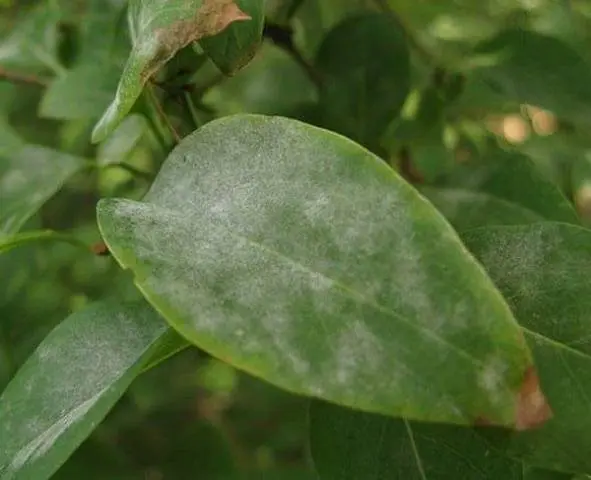
Honeysuckle Nymph is little affected by aphids. When attacked by scale insects or leafworm caterpillars, insecticides or biological preparations, such as Agrovertin, Iskra-bio, Fitoverm, should be used.
Of the diseases, attention should be paid to powdery mildew. This fungus appears on honeysuckle in cold rainy weather or during evening overhead watering. You need to fight it with fungicides, and if the disease manifests itself during the ripening of berries, with the biological drug Fitosporin or folk remedies.
Reviews










